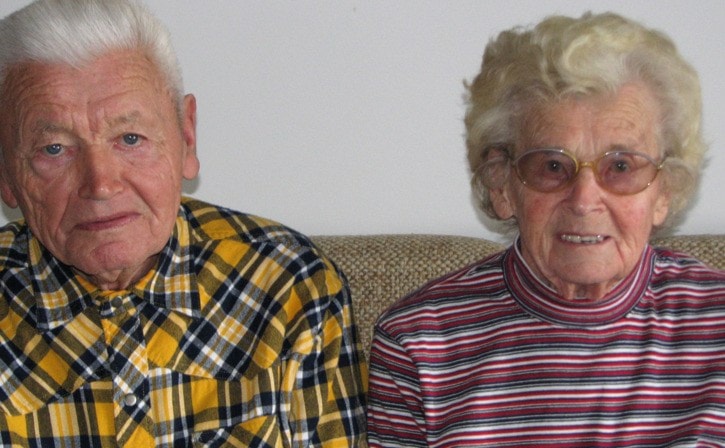

 Dick Kalman is well-known in Creston among the skiers, hikers and canoers as a giant. He proudly boasts that one winter in the not too distant past, he clocked 61 days of skiing and has recorded 14 trips up Haystack Mountain. He has hiked and canoed in the Yukon, north Saskatchewan, Bow River and Haida Gwaii. Kalman is now over 90, and he sadly retired from his favourite sports just two years ago.
Dick Kalman is well-known in Creston among the skiers, hikers and canoers as a giant. He proudly boasts that one winter in the not too distant past, he clocked 61 days of skiing and has recorded 14 trips up Haystack Mountain. He has hiked and canoed in the Yukon, north Saskatchewan, Bow River and Haida Gwaii. Kalman is now over 90, and he sadly retired from his favourite sports just two years ago.
Prior to his immigration, as a young man in 1942 he was the Hungarian champion in jumping and slalom. Then in 1943, he won the junior championship in downhill, slalom, cross-country and jumping combined. Dezso Kalman left his native Hungary in June 1948 to escape from Hungarian communism. He registered in Innsbruck to work with the International Refugee Organization to come to Canada. As a refugee, he signed a contract with the option to work in the Canadian Forest Service, on the Canadian Pacific Railway (CPR) or in a mine. Kalman chose the CPR, where he would work on the railroad changing rails from Dryden, Ont., and west.
He immigrated on a Polish ship, the S.S. Sobiesk, a 20,000-ton vessel, along with 18 other Hungarians, 40 Serbs and some Lithuanians. Upon arrival, he took out a loan of $150 to equip himself with the warm clothes, boots and more for his new job. He became a member of the “Green Gang” who all had signed a one-year contract to work on the expected expansion of Canada through the CPR. The work was hard, but Kalman was in good physical shape. His physical training for sports made it easier to work the long gruelling hours on the railroad.
After completing his obligatory agreement, he moved to Exshaw, Alta., to work for Canada Cement Co. He cleaned out the boxcars that the CPR pushed up from the track to Canada Cement. There was plenty of overtime, which enabled Kalman to quickly save enough to bring his fiancée, Barbara, a widow, and her six-year-old daughter over to Canada in 1949.
Kalman moved back to Calgary and worked swing shift , on the biggest type 5900 steam locomotives at the CPR roundhouse for nearly four years, but it went out of business, forcing Kalman to move on.
In 1949, after a year of hard physical work and determination, learning a new language and adapting to this young nation, he and Barbara were able to get married. Kalman began studying gas pipeline design at the Southern Alberta Institute of Technology and became very proficient, quickly becoming a self-employed contractor. The varied situations in which he worked provided valuable experience, and he soon gained quite a reputation for his designs.
He worked briefly in an oil refinery and did fieldwork, but found the high-paying jobs were a source of family problems, and decided to limit his work to no more than 100 miles away.
He built a house in Calgary and, on the advice of a Dutch colleague, he began buying land. He paid a deposit of $100 for four lots and made monthly payments. He planted trees bought from a First Nations group in the area to add greater interest to his investments, which increased their value significantly.
By now the Kalmans had a daughter, sister to Barb’s firstborn. The family spent the next 30 years in Calgary, hiking, skiing and hostelling in the Rockies. During this time, they thoroughly explored British Columbia and decided to move to Creston. Kalman designed and built his own house, and moved in in 1982.
Not too many people are aware that Kalman and his wife are accomplished artists. He and Barb decided that they needed to have something on their walls and decided to paint their own pictures. Barb had already experimented with painting and he was good at drawing. Now they have a house of beautiful paintings depicting their favourite hiking spots. Some of the older skiers will remember Kalman’s beautiful maps and cover on the visitors’ book up at the ski cabin on the Kootenay Pass summit. He has sold about 20 of the best paintings, but the memories of many hikes still adorn the Kalman home.
A few years ago, when Kalman’s health required him to stop skiing alone, and with his old cohorts gone, he found several ladies to accompany him on ski or canoe trips and the group became known as Dick and the Chicks. He still reminisces about the “old days” with other ski legends like Rae Masse and Dave Armitage.
Nowadays, in their nineties, the Kalmans still walk up to Extra Foods to shop, though they now find it a bit too much to walk back, as well, and are looking at ways to solve this. Even after losing his drivers’ licence, Kalman still shows the strong spirit which brought him through hard times to find his dream in Creston.
